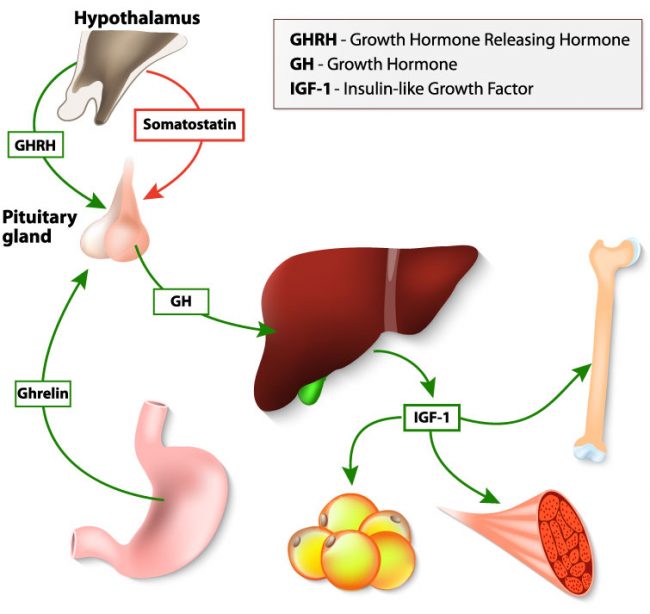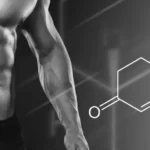Although the growth hormone (somatotropin, HGH) is not an androgenic hormone, it plays an important role in building and keeping muscle mass, and this is truer for the male body.
Note that after the puberty period, growth hormone levels in men and women are almost identical. However, due to the presence of various androgens in the male body, GH shows a number of interesting properties.
The effect of growth hormone on muscle mass growth is multifactoria.
Let us consider these factors:
1. The synergism of somatotropin and other anabolic growth hormones
Growth hormone (somatotropin) is considered to be an insulin antagonist, but due to its non-steroidal nature, it shows anabolic properties under certain conditions. The combined action of somatotropin with testosterone (as well as dihydrotestosterone) significantly accelerates the synthesis of protein, which allows for much more effective recovery after regular training, even high-intensity strength workouts.
It should be noted that the growth hormone interacts with completely different receptors than testosterone and often passes into cell membranes much easier than the latter. The only competitor of somatotropin in this area is insulin, which has a certain priority in human metabolism, but somatotropin can enter into mutual synergy with it also.
Through interaction with testosterone receptors other than testosterone, growth hormone receptors can simultaneously affect muscle cells, which allows for more effective muscle mass growth. It should also be remembered that somatotropin makes muscles insulin-resistant (insulin resistance is a violation of the metabolic response to endogenous or exogenous insulin), in a positive way.
In this state (insulin resistance), fat is used to restore energy metabolism and carbohydrates feed the central nervous system. Therefore, people with a higher level of the growth hormone are much less prone to overtraining. Their nervous system always gets the right amount of energy.
The growth hormone restricts the nutrition of the cell to some extent for a certain period of time, which creates a light stressful effect, which is overlapped due to supercompensation. As a result, the symplasts (muscle cells) get a little more nutrients.
2. Nitrogen retention
The growth hormone contributes to strong nitrogen retention, i.e. anabolism, which actively accelerates protein synthesis and leads to rapid muscle gain. In addition, this GH provides this process with energy. The fact is that protein synthesis is one of the energy-consuming processes.
Somatotropin mobilizes resources, in particular through the use of fatty acids, which allows you to conditionally save carbohydrates and proteins for the muscles, and direct fats to maintain protein synthesis. High levels of this hormone lead to higher levels of corticoid hormones (cortisol and others).
And this is a worrying opinion for many athletes who learn about it, as another opinion suggests that cortisol and its analogs are destroying muscle cells. However, cortisol (and other glucocorticoids) not only destroys muscle cells but also fatty cells (adipocytes). The growth hormone blocks nitrogen consumption and protects muscle fibers, leaving the adipocytes “to tear up the cortisol (glucocorticoids)”.
In general, it can be said that high levels of growth hormone are as important for muscle gain as high amounts of testosterone. Both hormones retain nitrogen and put the body in an anabolic mode.
3. Strengthening the ligamentous apparatus
 Somatotropin significantly improves the condition of joints and ligaments. It strengthens their structure and promotes the regeneration of damaged cells. This is a kind of prevention of various injuries during strength training.
Somatotropin significantly improves the condition of joints and ligaments. It strengthens their structure and promotes the regeneration of damaged cells. This is a kind of prevention of various injuries during strength training.
In the pre-puberty period, the growth hormone promotes bone growth and practically does not strengthen their structure, but after overcoming puberty somatotropin allows you to accumulate calcium in the bone tissue, which strengthens their structure.
These properties have a positive effect on an intense workout. Strong bones and joints allow you to work with heavyweight because tendon organs of Golgi get a higher threshold of triggering. (The tendon organs of Golgi protect the ligaments from ruptures by reducing the limiting threshold of nerve impulses sent to muscle fibers.)
4. Fat burning
It would seem that fat burning does not belong to the set of muscle mass, because these are two completely different biochemical processes, but not in this case. The fact is that a high level of somatotropin changes energy metabolism to the use of free fatty acids, including from blood and adipocytes (fat cells), which allows burning fat even at rest.
Effective fat burning allows you to increase muscle mass more efficiently. And to lose fat and at the same time to accelerate protein synthesis is possible only when you have high levels of growth hormone.
5. Slow muscle fiber growth
The growth hormone is one of the few anabolic hormones that can positively influence the growth of slow muscle fiber, which is more responsible for endurance. This property in combination with the strengthening of the joint ligament apparatus allows you to increase the strength of the athlete in exercises of any kind. This is due to the fact that any physical activity involves all muscle fibers, although to varying degrees.
The results
Somatotropin is not a direct initiator of muscle mass growth. This task in the body is assigned to testosterone and other androgens. Nevertheless, somatotropin “works” together with testosterone, causing a synergistic effect: it retains nitrogen and promotes the processes of recovery.
Therefore, we can safely recommend boosting the levels of somatotropin through proper nutrition and the best HGH supplements, quality sleep and, of course, specialized sports nutrition (amino-acids).

Mike Lilley is the author of many articles and reviews on our site. He is a fitness & bodybuilding blogger and co-founder of Boost Hormone. He writes product reviews based on the results of scientific research. From the great variety of information and products in this niche, he recommends only those that include science-based nutritional ingredients. Find Mike Lilley at SelfGrowth.




